- Growth marketing is a full-funnel, experiment-driven discipline optimizing acquisition, activation, retention, revenue, and referrals across teams.
- High-ROI levers include SEO, content, paid ads, email, influencers, social virality, PLG, referrals, community, and CRO.
- Success depends on rigorous experimentation, user-centric funnels, cohort-based metrics, and sustainable unit economics like LTV:CAC and payback period.
As someone who’s spent years working on both brand marketing and growth teams, I’ll be the first to admit: “growth marketing” is a term that gets thrown around way too casually. But at its core, growth marketing is not just another buzzword or rebranding of traditional digital marketing.
It’s a philosophy, a full-funnel, cross-functional discipline grounded in experimentation, iteration, and measurable results. Growth marketing isn’t just about driving traffic; it’s also about optimizing the customer experience. It’s about acquiring the right users, activating them quickly, retaining them long enough to drive LTV, and building the mechanisms to get them to bring others.
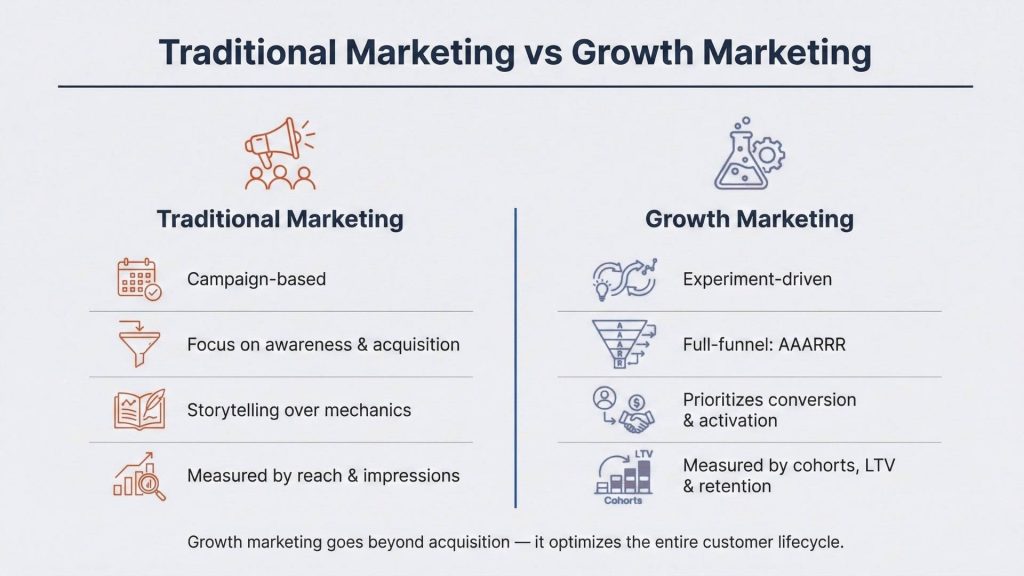
How Growth Marketing Differs from Traditional Marketing
Where traditional marketing often ends at the point of acquisition, growth marketing digs deeper. It cares what happens after someone signs up. Do they activate? Will they come back? Do they tell their friends?
Here’s how I personally think about the contrast:
| Traditional Marketing | Growth Marketing |
| Campaign-based | Experiment-driven |
| Focus on awareness & acquisition | Full-funnel (AAARRR: Awareness, Acquisition, Activation, Retention, Revenue, Referral) |
| Relies on brand storytelling | Prioritizes conversion mechanics |
| Success measured in reach, impressions | Success is measured in cohort-based metrics and LTV |
| Siloed teams | Cross-functional with product, engineering, and data |
Why It Works Across All Industries
What’s powerful about growth marketing is that it’s not industry-specific. I’ve seen teams in fintech, SaaS, e-commerce, education, and even healthcare apply growth marketing frameworks to drive exponential results. Whether you’re running a B2B startup or a legacy consumer brand, the key lies in adopting the growth mindset, testing everything, breaking assumptions, and building repeatable systems for scale.
In the sections that follow, I’ll walk you through each major channel and growth lever, with recent, high-quality, real-world examples from 2025 and earlier that show exactly how different companies are doing this. This isn’t a theory. It’s battle-tested practice.

Search Engine Optimization (SEO) as a Growth Engine
SEO Isn’t Dead. It Just Evolved.
People love to claim SEO is dying, especially with the rise of automation and AI-driven search. But as of 2025, it’s still one of the highest ROI channels I’ve ever used. Done right, it builds a compounding growth asset that drives qualified, high-intent traffic without paying per click. The trick is combining technical excellence, intent-mapped content, and ongoing iteration. SEO is no longer “set it and forget it.”
Let me show you how companies are using it as a growth driver across industries.
E-commerce: Compounding Results from Zero to Thousands of Keywords
One case that stands out is an e-commerce brand I reviewed in early 2025. When they began investing seriously in SEO in 2024, the site ranked for just 157 keywords. Within nine months, that number had grown to 5,500+ ranking keywords, and daily organic clicks increased from roughly 30 per day to over 200.
They didn’t just publish random blog posts. They did a full technical audit, the kind of systematic search process you’d normally see in a well-built SEO team, and fixed on-page issues (especially internal linking), built topic clusters targeting intent-based queries, and rolled out weekly content updates in real terms, that meant hundreds of extra customers each month, at zero incremental cost.
Fintech: Micro-Intent SEO that Converts
A fintech company working with a growth agency took a precision-based approach to SEO. Instead of chasing broad, competitive keywords like “best credit card,” they focused on tightly defined user pain points such as “how to improve your credit score before age 30.”
The results were significant. Over a single quarter, the site saw a sharp lift in organic clicks, added thousands of new ranking keywords, and generated meaningful customer signups directly from content. A small number of high-intent articles accounted for the majority of conversions.
The strategy worked because the content was aligned to real decision-stage search intent. By prioritizing queries that mapped to user problems, not vanity traffic, SEO became a revenue driver, not just a visibility play.
Healthcare: Cleveland Clinic’s SEO Domination
Even in industries that are traditionally slow-moving, like healthcare, SEO is a huge lever. Cleveland Clinic, for instance, built one of the most authoritative medical content libraries online. They didn’t just rank well; they became the go-to health source. Their blog traffic jumped from 200,000 to 3.2 million monthly visitors in under two years.
For a hospital group, that’s not just traffic. That’s long-term brand equity, national visibility, and a pipeline of prospective patients.
Key Takeaway
If you ignore SEO in your growth strategy, you’re leaving long-term value on the table. But it’s not about stuffing keywords anymore. It’s about:
- Matching content to user search intent (especially mid and bottom of funnel)
- Investing in internal linking and schema
- Optimizing for speed and crawlability
- Iterating on what’s already ranking (optimize top 10 pages quarterly)
- Using SEO tools like a product manager, not like an intern
Up next, we’ll dive into Content Marketing, the close cousin of SEO, and another pillar of sustainable growth.
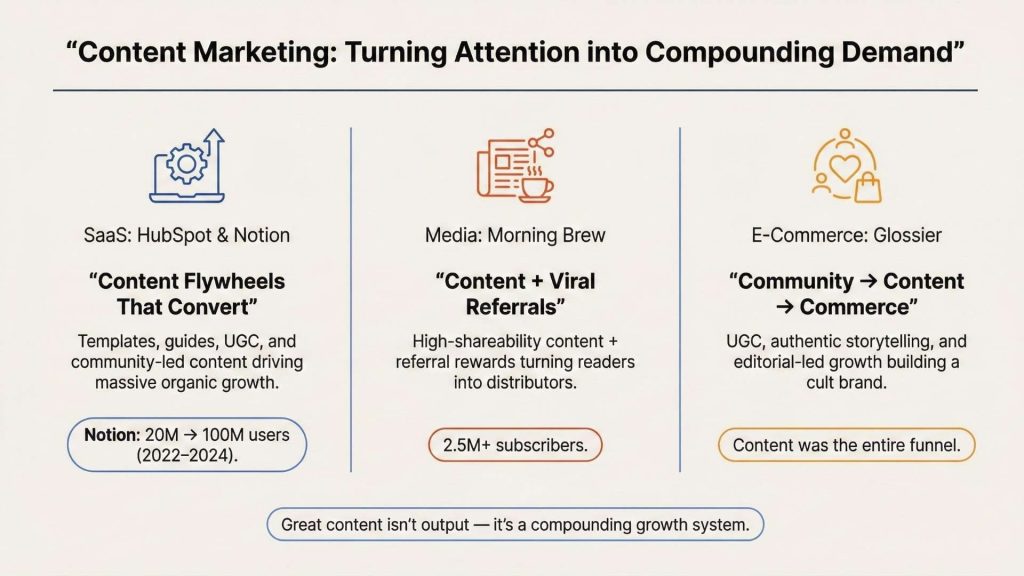
Content Marketing: Turning Attention into Compounding Demand
Content Marketing Is Not Just Blogging
If SEO is about visibility, content marketing is about persuasion and trust. It gives your audience a reason to care, return, and convert. But let’s be clear: content marketing isn’t just about spinning up a blog and praying for traffic. It’s a strategy that spans the entire funnel, especially when you connect your content engine to a broader SEO and distribution framework.
I look at content as one of the highest-leverage tools in any growth stack. Done right, it becomes a compounding asset that attracts and nurtures users month after month, even when you’re asleep.
SaaS: HubSpot, Notion, and the Inbound Flywheel
You can’t talk about content-driven growth without mentioning HubSpot. They pioneered the idea of inbound marketing by creating value-first content, including blog posts, templates, and e-books, which brought in millions of visitors and educated them into customers.
But what excites me more these days is what Notion has done. They didn’t stop at blog posts. They built:
- A vibrant template gallery (essentially a bottomless well of use-case content)
- Deep product how-to guides
- User-generated videos and workflows
- Localization and community ambassador content
All of this sits under their broader community-led growth engine, which I’ll expand on later. But the core principle is that Notion’s content educates, inspires, and empowers. By the time someone hits the signup page, they’re already sold.
And this wasn’t just a vague “brand awareness” play. By 2022, Notion had already passed 20 million users by 2021–2022, and was reported to have 100 million users by 2024. Multiple case studies indicate that most of this growth was driven organically through community, creators, and template-driven content loops, with minimal expenditure on paid advertising. By mid-2025, much of that growth was credited to community + content loops that brought in new users at virtually no CAC.
Media: Morning Brew’s Referral-Driven Growth Engine
Let’s look at a totally different playbook.
Morning Brew didn’t create content to sell software. They created content as the product. But what made them brilliant growth marketers was how they gamified distribution.
They built a viral referral system inside their newsletter:
- Share with 3 friends? Get bonus content.
- Refer 10? Get Brew swag.
- Hit 25? Get into the exclusive Brew Insider Slack group.
By combining content people wanted to forward with clear incentives, they turned readers into distributors. This strategy helped them surpass 2.5 million subscribers, and at one point, referrals drove nearly one-third of all new signups.
It’s a case study in aligning great content with growth mechanics.
E-commerce: Glossier’s Editorial Content Flywheel
Now let’s switch lenses again. Glossier didn’t start with products they started with a beauty blog: Into The Gloss. That blog built a loyal readership by publishing long-form, authentic interviews with real people about skincare and beauty. When Glossier finally launched its first products, it didn’t need to “find” an audience. The audience was already there, asking for the brand to exist.
And even after launch, content stayed at the very center of Glossier’s growth engine. The brand leaned into a content loop that most DTC companies still struggle to replicate:
- User-generated tutorials showcasing real routines from real customers
- Customers-as-models, replacing the polished, inaccessible aesthetic dominating beauty at the time
- Instagram storytelling, where the feed wasn’t just product shots but narratives, identities, and community culture
- Peer-to-peer sharing and word of mouth are amplified by a hyper-engaged community
Industry analyses point to this very loop community → content → more community → more content as the core of Glossier’s early hypergrowth. They didn’t scale through traditional advertising. They scaled because people wanted to talk about them, share them, and be part of them.
Content wasn’t just part of Glossier’s funnel. It was the funnel.
What This Means for Growth Teams
If you’re serious about growth, you need to treat content like a product in itself. That means:
- Mapping content to each stage of the funnel (TOFU, MOFU, BOFU)
- Prioritizing intent over volume (ask: will this piece drive action?)
- Creating content that can be atomized (a webinar becomes a blog post, a tweet thread, a carousel, and an email series)
- Optimizing old content for conversions, not just rankings
- Building content systems, not content assets (e.g., template libraries, documentation hubs, calculators)
The companies that scale with content don’t just write. They architect content systems that scale traffic, leads, and LTV.
Paid Advertising: Precision, Not Spray and Pray
Let’s Be Honest: Paid Ads Can Burn Cash Fast
If you’ve been burned by paid ads before, I get it. I’ve sat through too many meetings where someone insisted “we just need to spend more” while ignoring that cost-per-acquisition was climbing and LTV wasn’t budging.
But paid ads aren’t the problem.
The problem is how most people run them, often without any structured marketing management framework guiding experimentation. Growth marketing treats paid acquisition like a laboratory, not a billboard. Every dollar spent is a test. And everything from copy to creative to targeting to landing page is measurable, tweakable, and scalable, if you know what you’re doing.
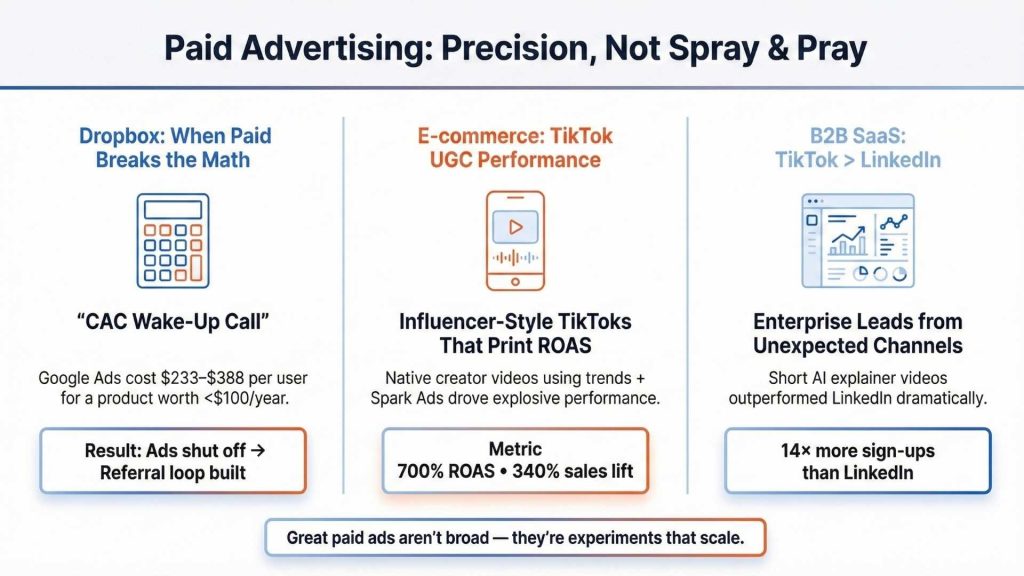
Case Study: Dropbox and the CAC Wake-Up Call
Here’s a story every founder and CMO should internalize.
Dropbox initially attempted to run Google AdWords to acquire users. They quickly found that they were spending between $233 and $388 per customer, while the product itself had an annual value of less than $100 per user.
So what did they do?
They shut it down. That failed experiment is what pushed them to build their legendary referral loop instead (more on that later). But it also taught their growth team to treat paid acquisition as a performance channel, not a hope-and-pray channel.
You don’t just run ads because your competitors do. You run them because the math checks out: LTV > CAC, ideally by at least 3:1.
E-commerce: TikTok + Influencer Creative = Multi-X ROAS
Now for a counter-example of it working beautifully.
A European fashion e-commerce brand wanted to scale without pouring budget into generic Meta ads. Instead, they ran TikTok campaigns built entirely around user-generated, influencer-style content that felt native to the platform.
- Creators filmed themselves styling the brand’s clothing
- Videos used trending sounds and casual, unpolished editing
- High-performing posts were amplified using TikTok Spark Ads
The outcome was dramatic:
- Multi-X ROAS from paid TikTok campaigns
- Triple-digit growth in online sales
- Highly efficient targeting by region and interest group
This wasn’t a “blast broad ads with a discount code” strategy. It was thoughtful, platform-native, and creative-led. That’s growth marketing with paid media: don’t just buy eyeballs, earn conversions.
B2B SaaS: TikTok for Enterprise? Yes, Really.
You might think TikTok is just for beauty brands and 20-year-olds. Think again.
A B2B SaaS company in Belgium created short, sharp TikToks that explained AI use cases for businesses in 30–45 seconds. Some were organic. Others were promoted.
The performance shocked even them:
- TikTok drove significantly more sign-ups than LinkedIn for the same spend
- Lower CPMs, higher engagement, and faster funnel movement
It turns out that decision-makers are human too. They scroll TikTok. They click when something speaks to a real need.
The key insight here is: paid ads work best when they meet your audience where they already are, with content they’d actually choose to watch.
How Growth Teams Run Paid Ads
Here’s what separates growth marketers from old-school media buyers:
- Every campaign is an experiment.
- Multiple creatives, headlines, CTAs, and angles are tested in parallel.
- Ad spend is divided into micro-budgets and scaled only after results.
- The funnel is owned end-to-end.
- A/B testing doesn’t stop at the ad.
- Landing pages, onboarding flows, and pricing pages are optimized in parallel.
- Attribution is rigorous.
- Cohort-based LTV and payback period are monitored.
- Campaigns are killed quickly if unit economics break.
- Creative is king.
- Most growth teams spend more time testing ad creatives than audience segments.
- Winning ads often come from lo-fi, customer-style videos, not polished brand reels.
- Cross-channel integration.
- The best paid campaigns work in sync with owned media: retargeting site visitors, reactivating email lists, and driving to a product-led onboarding flow.
Key Lessons for Practitioners
- If you’re not getting a minimum 3:1 LTV: CAC, rethink the campaign.
- Don’t scale ad spend until you’ve found a repeatable winner.
- Focus on creative testing first, not targeting hacks.
- Use real-time product behavior to power retargeting (e.g., cart abandoners, feature drop-offs).
- Stop thinking in “channels.” Paid should feed your entire funnel.
When paid media is used the right way, as growth marketers do, it’s not just a cost center. It becomes a growth multiplier, especially when paired with strong activation, upsell, and referral engines.
Email Marketing & CRM: The Workhorse of Lifetime Value
Most Brands Still Underestimate Email
If I had to build a lean growth stack with just one channel, I’d pick email. Not because it’s flashy. Not because it wins awards. But because email prints money when done right.
Here’s the truth: most businesses still treat email as an afterthought. They send a weekly promo blast and call it a day. Meanwhile, top growth teams are utilizing behavior-based triggers, often powered by streamlined automation systems that reduce manual work and increase accuracy.
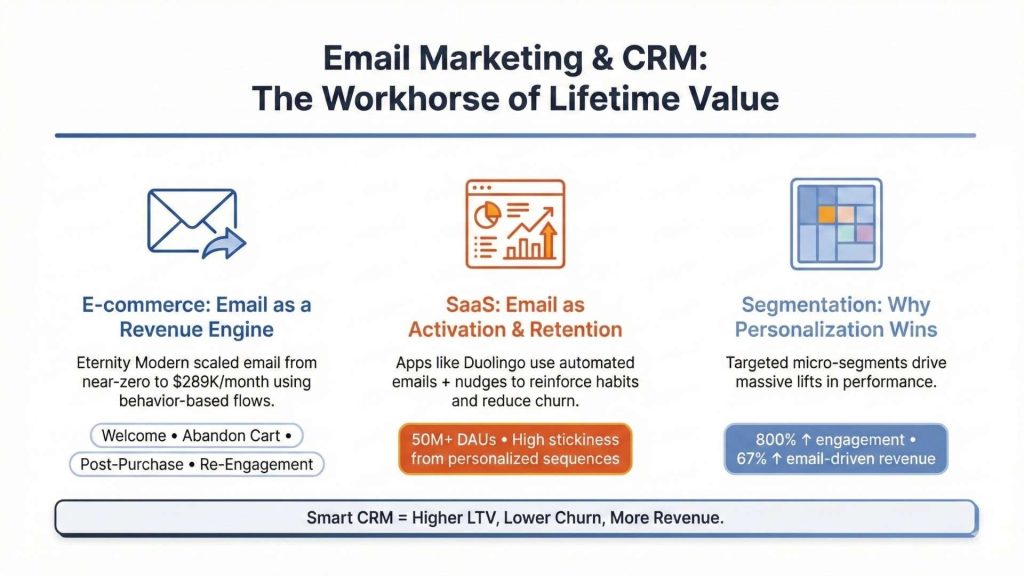
Let me show you what this looks like in practice.
E-commerce: How Eternity Modern Pulled $289K/Month from Email
In 2020, Eternity Modern, a furniture brand, was barely using email. Their list was cold, their flows were nonexistent, and revenue from email was close to zero.
Fast forward to less than a year later, after implementing lifecycle automation:
- $289,000 per month in email-driven sales
- 9+ triggered flows, including:
- Welcome series
- Cart abandonment
- Post-purchase upsells
- Re-engagement campaigns
- Product education
- Segmented campaigns with personalized product recommendations
And this wasn’t rocket science. It was basic growth hygiene done right:
- Segment your audience by behavior and purchase history
- Use Klaviyo (or similar) to build flows with logic-based triggers
- Continuously A/B test subject lines, CTAs, and email layout
- Optimize send times and frequency to avoid fatigue
What I loved most about their setup is how each flow was built around a specific user action or inaction. That’s the magic of growth-driven CRM: it’s reactive, personal, and relevant.
SaaS & Mobile: Email as Onboarding and Retention Engine
Email’s not just for commerce. In SaaS, it’s often your only direct line to the user, especially between product interactions.
Take Duolingo, for example. They use emails and push notifications to reinforce habit formation:
- Reminders to maintain daily streaks
- Nudges to return after churn risk behavior
- Personalized progress reports
- Re-engagement emails when users skip multiple days
The result? As of 2025, they’re maintaining over 50 million daily active users with a DAU/MAU ratio of 37%. That’s unheard of for an education app. And email plays a huge role in keeping users emotionally engaged.
Another example: many SaaS tools send activation sequences right after signup:
- “Hey, you haven’t used the X feature yet.”
- “Here’s how to get more value from your account.”
- “Your teammate just joined, collaborate now.”
These don’t just “increase engagement.” They reduce churn. They get users to the Aha Moment faster. They close the loop between acquisition and retention.
Segmentation: Why Spray-and-Pray Is Dead
If you’re still blasting every email to your entire list, you’re not just wasting sends, you’re burning trust. Modern growth CRM is built around targeted micro-segments, not giant, undifferentiated lists.
In B2C retail, this shows up clearly:
- Recent purchasers receive replenishment or complementary product recommendations
- High-value customers get early access to launches or exclusives
- Lapsed users see re-engagement offers based on prior browsing or purchase behavior
In one campaign review, introducing proper segmentation led to multi-X increases in engagement and a substantial lift in email-attributed revenue, not marginal gains, but a fundamental shift in channel performance.
Industry benchmarks back this up: segmented email campaigns consistently outperform batch-and-blast emails by wide margins, often driving several-hundred-percent lifts in revenue.
That’s not optimization. That’s transformation.
How Growth Teams Treat Email
Here’s what separates high-performance CRM from the noise in your inbox:
- Flows > Campaigns
Static newsletters die. Triggered flows based on real behavior win. - Behavior-based Targeting
What someone does (or doesn’t do) determines what they see. - Relentless Testing
Subject lines, send times, CTA order, image vs no-image, everything gets tested. - Cohort Tracking
Growth teams track LTV, retention, and revenue attribution for each segment. - Cross-Channel Sync
Email works best when aligned with product, ads, and in-app messaging.
If email isn’t driving 20–40% of your total revenue (for e-comm) or significantly impacting activation (in SaaS), you’re leaving growth on the table.
Influencer and Affiliate Marketing: Growth Through Borrowed Trust
Scaling Fast by Tapping Into Audiences That Already Exist
Here’s the beauty of influencer and affiliate marketing from a growth perspective: you don’t have to build the audience from scratch. You tap into someone else’s distribution, and if you structure it well, they’ll do the selling for you.
What matters isn’t reach. It’s trust. Influencers and affiliates have already built rapport with their followers or readers. Your job is to make it a win-win for them to talk about your product.
This isn’t brand marketing fluff; it’s a structured acquisition path powered by affiliate-style distribution loops that scale efficiently.
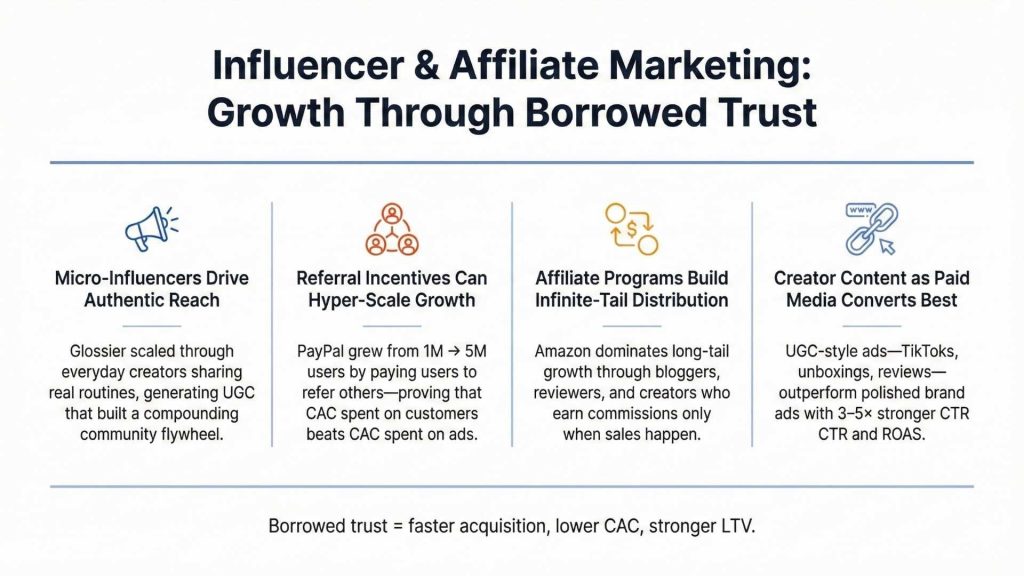
Let’s look at how this works in practice.
Glossier: The Micro-Influencer Masterclass
Glossier didn’t start by paying Kylie Jenner. They built a network of micro-influencers, real people with small but loyal followings, who genuinely loved the product and were excited to share it.
They created an ambassador program where customers:
- Shared their own makeup looks on Instagram
- Created “Get Ready With Me” videos using Glossier products
- Got early access or small perks for being part of the community
This grassroots strategy turned everyday users into marketing channels. Glossier didn’t just generate reach. They created a community-powered flywheel of user-generated content (UGC) that compounded over time.
According to public interviews and early-stage reporting, Glossier claimed up to 600% year-over-year growth in its early years, a rapid rise driven by community buzz, micro-influencers, and user-generated content. Within a few years, the brand had surpassed US$100 million in revenue, validating the power of its grassroots growth strategy.
PayPal: Paying for Word-of-Mouth (and Winning Big)
PayPal, in the late ‘90s, was one of the first to prove that referral-based influencer mechanics could scale at speed. They literally paid people $10–$20 to refer others and to sign up themselves.
It was expensive. But it worked. They grew from 1 million to 5 million users in just a few months, and those referred users were more engaged and had higher LTV.
That’s the affiliate model at work: high payout, but only on conversion.
Growth teams learned from this that spending CAC on your users, rather than on Facebook or Google, can build trust, loyalty, and momentum.
Amazon: The Quiet Behemoth of Affiliate Strategy
Amazon’s affiliate program has been one of its stealthiest growth levers for decades. Bloggers, YouTubers, review sites, and niche influencers all link to Amazon and get a commission.
What’s smart here is that Amazon created an infinite tail distribution:
- “Top 5 humidifiers under $50” blog? Affiliate link to Amazon.
- “What’s in my bag?” video? Affiliate link to Amazon.
- Comparison tables for tools, supplements, books, and gear? All roads lead to Amazon.
Amazon doesn’t pay until there’s a sale. And because they own the checkout and recommendation engine, they convert better than anyone.
This kind of long-tail affiliate moat is something most brands still haven’t fully tapped.
SaaS and Fintech: Affiliates Driving Qualified Signups
In B2B SaaS and fintech, affiliates often take the form of:
- Review sites
- Comparison blogs
- Niche creators or YouTubers
- Partner ecosystems (e.g., accounting software recommending banking tools)
For example, fintech startups offering high-yield savings accounts often work with finance influencers and bloggers who write detailed product comparisons. When a reader clicks and signs up, the affiliate gets a fixed bounty. Fintech gets a qualified, high-intent user.
I’ve worked with companies where this channel drives 25–30% of new signups, with CAC below what they’d pay on Google Ads, and better conversion rates.
Influencer Creative as Paid Media
There’s also a hybrid approach that’s exploding in 2025: using influencer-generated content as paid ads.
Instead of polished, agency-created video ads, growth teams repurpose:
- TikTok reviews
- Unboxing videos
- Instagram stories
- Customer testimonials
Why? Because these perform better. The content feels native, trustworthy, and real. Multiple platform case studies show that Spark Ads and other creator-led formats can outperform traditional brand ads often by multiples in CTR and ROAS when the content feels native to the feed.
This strategy blends UGC + paid scale, and it’s especially powerful when testing new angles or markets.
How to Build Growth-Centric Influencer and Affiliate Programs
If you want to build this channel right, here’s how I recommend doing it:
- Choose the Right Partners
- Micro > macro for trust
- Affiliates with niche authority > generic reach
- Align Incentives
- Use double-sided rewards when possible
- Tier rewards based on performance (e.g., power users earn more)
- Track Everything
- UTM codes, dashboards, tier-based dashboards
- Track conversions, not just clicks
- Provide Assets and Support
- Give affiliates swipe copy, graphics, templates, and onboarding calls
- Make it easy for them to promote
- Integrate with Product and CRM
- Trigger referral nudges after high NPS actions
- Use email and in-app cues to promote ambassador programs
When done well, this channel becomes a self-reinforcing acquisition loop; your best users bring in your next best users.
Social Media and Viral Campaigns: Engineering Shareability
Virality Isn’t Magic. It’s Manufactured.
Let me say this upfront: going viral isn’t a matter of luck. It’s architecture. Virality is increasingly influenced by the cultural vibe and emotional tone brands bring into the social feed. Smart growth teams engineer shareability into content, products, and user experiences from the beginning. Social media isn’t just for posting content; it’s for triggering behaviors that scale organically.
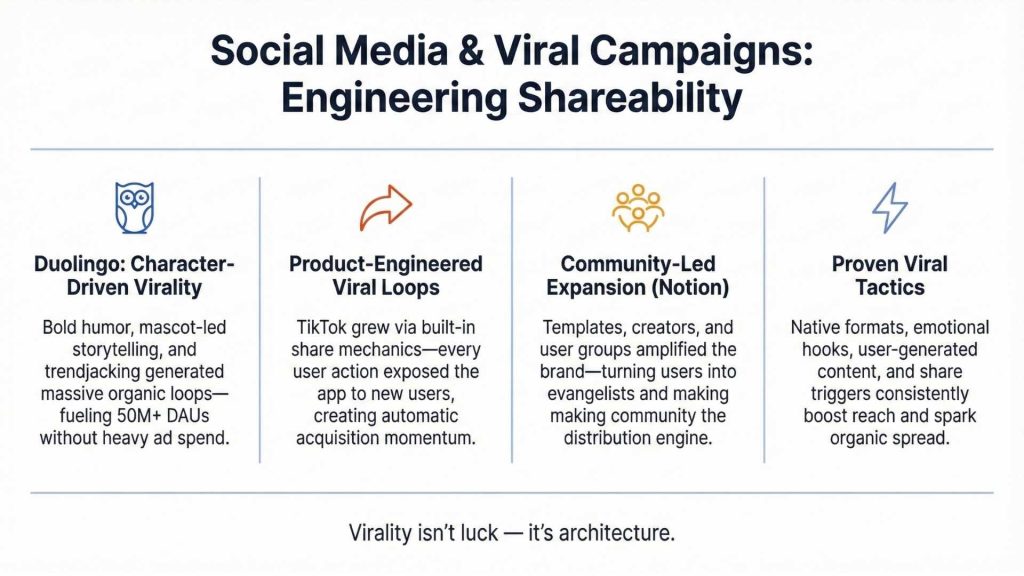
The best campaigns don’t just get shared. They make people look good for sharing them.
Here’s how we see this working across industries.
Duolingo: From Language App to Meme Machine
If there’s one brand that’s absolutely crushed social media in the last few years, it’s Duolingo. And I’m not just talking about follower counts.
Their secret? They embraced a bold, irreverent, highly human brand voice, anchored by their owl mascot “Duo,” who became a viral TikTok star in his own right.
They posted:
- Skits where Duo was jealous of other language apps
- Behind-the-scenes humor from the Duolingo office
- Cultural trendjacking videos around music, news, and internet drama
One of their campaigns in 2025 (faking Duo’s “death” as a joke) even trended across TikTok and X (formerly Twitter), driving a spike in organic traffic and app installs.
Behind the humor, the results speak volumes:
- Duolingo has around 103 million Monthly Active Users (MAU), depending on source.
- As of Q3 2025, Duolingo reports 50 million+ Daily Active Users DAUs
What growth marketers should learn from this is that authenticity and consistency win on social, not overproduced brand commercials.
Product-Embedded Virality: TikTok’s Own Playbook
TikTok itself grew into a 1.6+ billion user juggernaut largely without ads in the early days. How?
By engineering shareability into the product:
- Every video could be shared on Instagram, Snapchat, and WhatsApp
- Non-users who viewed a TikTok were prompted to download the app
- Creators were incentivized to go viral (the algorithm favored new accounts)
That’s what we call a viral loop. Every user action leads to exposure to new users, which leads to more content and more sharing.
This wasn’t accidental. ByteDance designed the mechanics for maximum amplification.
If your product has any social element, comments, invites, exports, even email reports, you should be thinking about how to turn every interaction into an acquisition opportunity.
Community Buzz: Notion’s Social Expansion
Notion is another great example of community-driven virality on social.
The Notion team didn’t try to build a cult brand with flashy videos. Instead, they empowered users to:
- Share their custom templates on Twitter, YouTube, and TikTok
- Join and run Facebook groups
- Host local meetups or post workflows in Reddit communities
One user even built an entire fan site for Notion templates, which Notion later promoted officially.
By the time Notion had hired a Head of Community, users had already created the movement. The team simply nurtured it and gave it visibility.
That’s a playbook I’ve followed myself: find your power users and make them famous. Give them the tools, attention, and platform to spread the word.
Viral Campaign Tactics That Actually Work
Here’s what I’ve seen consistently drive exponential social reach:
- Embrace Native Format
- Don’t repost YouTube videos on TikTok.
- Use trending audios, filters, platform-native humor, and pacing.
- Make Users the Hero
- Share user content.
- Create challenges or stories where they’re featured.
- Emotion > Information
- Humor, outrage, nostalgia, surprise, those get shared.
- A 90-second product tutorial? Maybe not.
- Add Share Triggers
- In-app share buttons, rewards for sharing, viral onboarding flows.
- Think Calendly, where every invite exposes new users.
- Reverse Engineer Distribution
- Build for the feed first, then layer in CTA or product messaging.
Real-World Wins Across Sectors
- Venmo made transactions public by default. Friends saw friends using it. Curiosity exploded.
- Canva saw growth by letting users export social-ready graphics with a watermark and CTA.
- Strava turned fitness tracking into social proof; every run you log gets posted and compared.
Social media isn’t just a channel. It’s a network effect accelerator when paired with product usage.
The question I always ask: If a user loves your product, how easy have you made it for them to show the world?
Product-Led Growth (PLG): Letting the Product Do the Selling
The Product Is the Funnel Now
There was a time when marketing drove demand, and sales closed deals. That still happens, but in many of today’s fastest-growing companies, the product itself is the primary growth engine.
This is the world of product-led growth.
Instead of throwing bodies and budget at acquisition, PLG companies build products that:
- Sell themselves through usage
- Encourage virality through sharing or collaboration
- Nurture upgrades by delivering value before asking for money
The best part? It scales with usage, not headcount.
Let me show you how the leaders do it.
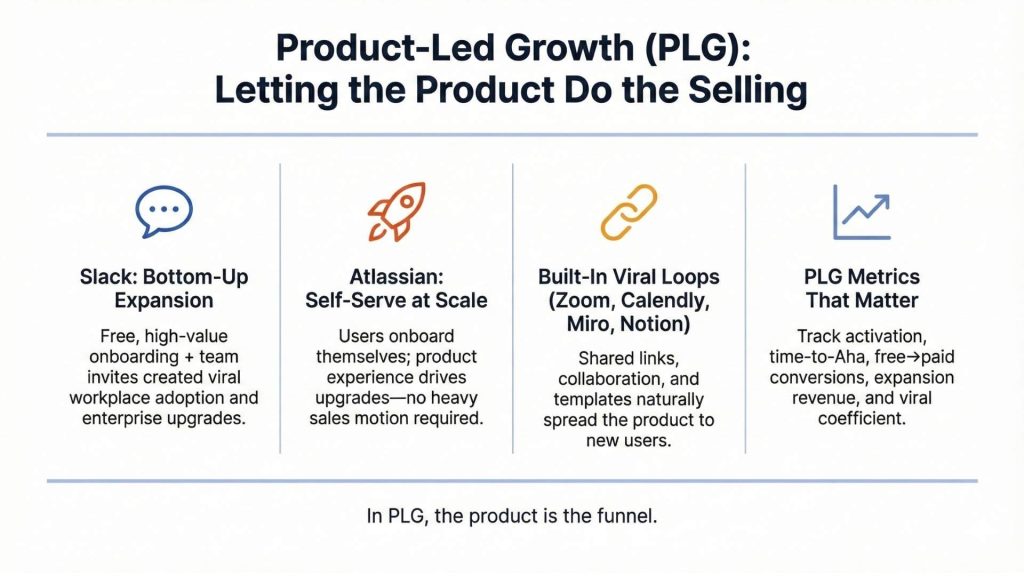
Slack: Bottom-Up Wins the Enterprise
Slack didn’t win because it was cold-called CIOs. It won because small teams started using it for free, and loved it so much, it spread organically inside their orgs.
That’s PLG in action:
- Free plan with real utility
You didn’t need a credit card to start using Slack with your team. - Quick activation
Invite teammates, send a few messages, upload a file, value delivered in minutes. - Expansion loop
As more people joined, the platform became more useful.
Eventually, companies upgraded not because a salesperson convinced them, but because Slack was already the backbone of internal comms.
That’s how they reached 40+ million daily active users and enterprise dominance without behaving like a traditional enterprise software vendor.
Atlassian: No Sales Team, No Problem
Atlassian (makers of Jira, Confluence, Trello) famously scaled to $100M+ in ARR without a formal sales team. Their model was simple:
- Provide high-value tools for small teams
- Let users onboard themselves
- Offer frictionless upgrades for teams or usage growth
Their customers are essentially self-qualified. The product did all the talking.
Atlassian now generates over US$5 billion in annual revenue, having grown past the $3 billion mark years ago evidence that its product-led, self-service + upgrade motion scaled massively. According to public financial data, in 2025 the company reported ~US$5.2 B revenue.
No ads. No cold outreach. Just PLG at scale.
Calendly, Zoom, Miro, Notion: Viral Loops Built-In
Here are a few other PLG champions worth noting:
- Calendly: You use it to book a meeting → the invitee sees how easy it is → they sign up. Instant viral loop.
- Zoom: Free plan with 40-minute limit. People hit the wall and upgrade. Plus, every invite creates exposure to new users.
- Miro: Collaborative whiteboards designed for team usage. The more collaborators, the more value, and the more accounts.
- Notion: Users create and share templates, which get indexed by Google, shared on Reddit, and spread organically.
All of these products are spread by design. The user experience is the marketing funnel.
What PLG Requires Behind the Scenes
Now, none of this happens automatically. Successful PLG relies on serious investment in:
- User Onboarding Optimization
- Clear Aha Moments within the first session
- Guided walkthroughs or tooltips (or none, if the UX is intuitive enough)
- Usage Analytics
- Tracking product events to understand friction points
- Identifying which features correlate with long-term retention
- Free-to-Paid Conversion Triggers
- Usage caps (e.g., # of projects or team size)
- Feature gating (e.g., integrations, security features, analytics dashboards)
- Virality Mechanisms
- Invite flows, collaboration, file sharing, and social integrations
- Making shared objects (calendars, boards, docs) leads to account creation
- Support Content and Community
- A knowledge base that reduces friction
- Power user communities that turn into evangelists
In PLG, growth marketing overlaps heavily with product management. The growth team often owns key metrics, such as activation, engagement, free-to-play conversion, and expansion revenue. These aren’t vanity metrics. They drive the business.
Metrics That Matter in PLG
If you’re running or advising a PLG company, here’s what to track obsessively:
- Activation Rate: % of new users who reach the core value milestone
- Time to Aha: How quickly users hit their first successful outcome
- Free-to-Paid Conversion Rate
- Net Dollar Retention: Are existing users expanding?
- Referral / Viral Coefficient: Do users bring in others?
If you optimize these levers, paid marketing becomes optional, not mandatory.
PLG is efficient, scalable, and incredibly defensible once network effects kick in. But it requires precision. Your product has to truly deliver value. You can’t “PLG your way” out of a weak product.
Referral Programs: Viral Growth with Predictable Economics
When Users Become Your Best Marketers
If you’re trying to scale without burning a pile of cash on paid ads, referral programs are your secret weapon. Done right, they convert your happiest users into a self-sustaining acquisition engine.
But here’s the thing: most referral programs fail because they’re bolted on as a gimmick. Growth teams that win with referrals build them into the core product experience, aligned with user incentives and value.
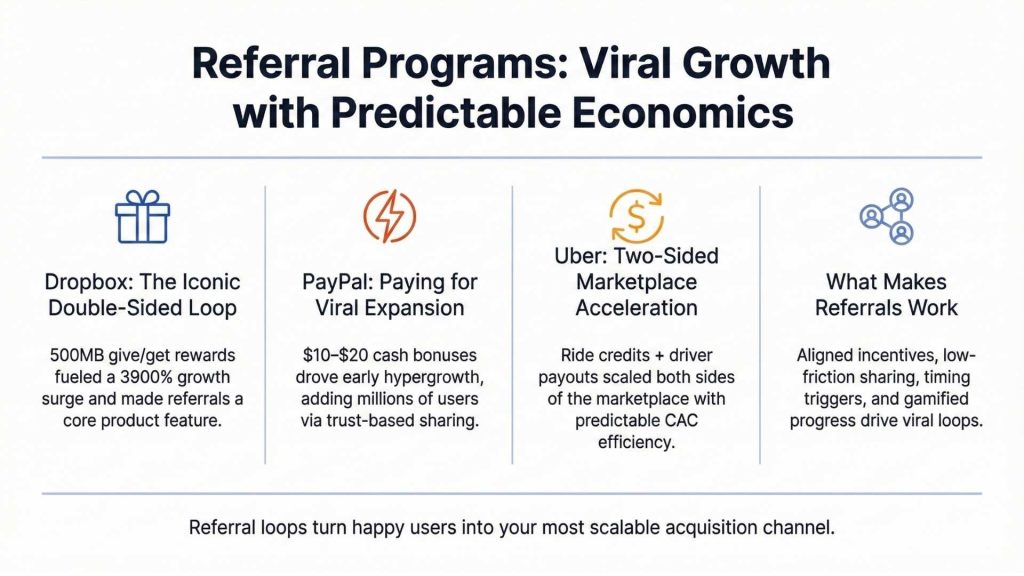
Let’s look at the real-world playbooks that scaled to millions, cheaply and effectively.
Dropbox: The Blueprint Everyone Still Follows
Dropbox is practically a textbook example. After finding that Google Ads were way too expensive (with CACs up to $388 for a product with sub-$100 LTV), they launched a double-sided referral program.
- Give 500MB of free space, get 500MB for each successful referral.
- The reward was aligned with product value.
- It was seamlessly integrated into the product; every user saw it post-signup, post-upload, and in the nav bar.
The outcome?
- 3900% user growth in 15 months
- 35% of daily sign-ups came from referrals
- A persistent 60% boost in organic growth long after the initial program launch, according to a detailed breakdown of Dropbox’s referral program.
Dropbox didn’t treat it as a one-off promo. They made it a permanent feature of the product, and it scaled like wildfire.
PayPal: Buying Growth (Intelligently)
PayPal, in the late 1990s, was one of the first to prove that referral-based influencer mechanics could scale at a rapid pace. They literally paid people around $10–$20 to refer others and to sign up themselves.
But it worked. Fast.
- 7–10% daily user growth
- Over 5 million users within a few months
- Cost of ~$60M in referral bonuses (but a bargain considering the network effects it created)
They weren’t just buying installs. They were buying users who brought more users; each new signup often referred several others.
That’s a viral loop with cash as the lubricant. You couldn’t run this forever, but as a launch tactic? It was game-changing.
Uber: Scaling Two Sides of a Marketplace
Uber’s growth team knew early on that both riders and drivers needed to grow in tandem. So they implemented referral programs on both sides:
- Riders: “Give $5, get $5” ride credits.
- Drivers: Referral bonuses up to $200–$500, depending on the city.
This did two things:
- Created FOMO and urgency in users to refer quickly.
- Created a predictable CAC model, with full control of payout tiers.
Internally, Uber measured the LTV:CAC ratio of referred users and found that referrals outperformed ads on ROI. One stat that stuck with me: referred users had 25% higher LTV than those acquired via paid channels.
The program was so effective that for a while, 50% of Uber’s new users came via referrals in key markets.
Why Referrals Work When Everything Else Fails
Referrals scale because they’re:
- Trust-based: Friends trust friends, not ads.
- Personal: The message isn’t generic, “Hey, I use this, and I think you should too.”
- Motivated: Give the right incentive, and users will sell for you.
But again, referrals don’t fix a bad product. They amplify a product people already love.
As Andrew Chen said:
“Referral programs don’t create product-market fit. They just accelerate it.”
Anatomy of a High-Performance Referral Program
Let me break down the elements you need to get this right:
- Double-sided incentives
Single-sided is weaker. When both parties win, motivation goes up. - Reward alignment
Give value that feels natural in the product (Dropbox: storage, Uber: ride credits, SaaS: free month or pro feature). - Low-friction sharing
Easy to copy links, auto-fill invites, mobile-first design, embeddable widgets. - Strategic surfacing
Show referral CTAs after successful moments: completed project, delivery, purchase, milestone. - Built-in fraud protection
Limit same-IP referrals, verify accounts, and cap rewards per user or per month. - Track and celebrate
Let users see their referral progress visually. Add tiers or streaks. Gamify it. - Iterate and optimize
A/B test reward types, placement, copy, and reward thresholds.
Don’t Sleep on B2B Referrals
Referrals aren’t just for B2C. In SaaS, I’ve seen referral engines work exceptionally well when:
- You incentivize account admins or power users
- You reward team expansion (e.g., “Get 10 teammates on and earn 1 month free”)
- You pair it with affiliate logic for agency partners or consultants
You’d be surprised how many B2B SaaS products still rely 100% on outbound or SEO, while ignoring that happy users are often your best salespeople, if you give them a nudge.
Community Building: Turning Users into Evangelists and Operators
Community Isn’t a Channel. It’s an Asset.
Most teams treat the community like a marketing afterthought. They launch a Discord server or a Facebook group, post a few updates, and expect it to grow magically.
But for those of us in growth, community is something else entirely.
Done right, it becomes:
- A distribution engine
- A support layer
- A content generator
- A retention booster
- And a flywheel for organic acquisition
The most successful growth marketers treat community like product infrastructure. Let me show you how.
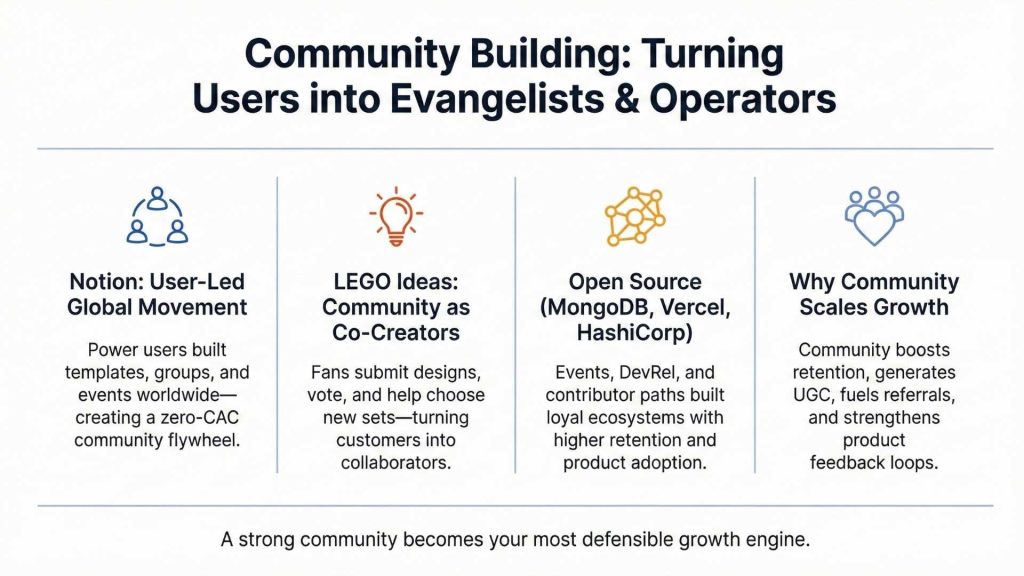
Notion: Scaling Through User-Led Movements
One of the most iconic community-driven growth stories is Notion.
They didn’t create a community because it was trendy. Their users built it for them.
In the early days:
- Power users started making Notion templates
- Others built unofficial Facebook groups, Reddit subs, and fan sites
- Notion embraced them, promoting their content, giving access, and eventually formalizing a global ambassador program
By mid-2020s:
- They had local Notion communities in 50+ countries
- Ambassadors were hosting meetups, creating content, and translating docs
- Entire product ecosystems (paid template marketplaces, YouTube channels) formed around Notion
And what did this mean for growth?
- A steady stream of UGC and SEO-rich pages
- Zero-CAC acquisition through user referrals
- Localized growth in markets without a single ad dollar spent
It was community-led distribution at scale.
LEGO Ideas: Community as Product Development
Let’s jump to a very different topic: toys.
LEGO launched “LEGO Ideas,” where fans submit new set concepts. If an idea gets 10,000 community votes, LEGO reviews it. If approved, they turn it into a real product and credit the creator on the box.
The result?
- Thousands of passionate users are submitting and voting on designs
- Viral buzz when fan-designed sets hit shelves
- A direct pipeline of pre-validated product innovation
More importantly, they turned passive customers into active collaborators. That’s the magic of community: people don’t just use the brand, they identify with it.
Open Source and DevRel: MongoDB, Vercel, and Beyond
In developer ecosystems, community is everything. No one scales open-source projects through ads.
MongoDB, Vercel, and HashiCorp all grew by:
- Hosting community events and hackathons
- Investing in developer relations (DevRel) teams
- Creating ambassador programs and open-source contributor paths
- Building thriving online forums and Slack/Discord communities
This wasn’t just for warm fuzzy feelings. It directly impacted:
- Product feedback loops
- Talent acquisition
- Enterprise deal expansion (companies follow where developers go)
I’ve worked with PLG teams where engaged community users had 3–4× higher retention and LTV. Why? Because the community creates stickiness that no onboarding flow can replicate.
Metrics That Matter
You can’t just launch a community and hope for the best. Like any growth lever, it needs measurement. Here’s what I track:
- Engaged members: Active users, not just sign-ups
- User-generated content volume: Templates, tutorials, posts
- Event participation: RSVPs, check-ins, repeat attendees
- Referral velocity: Are community members referring to new users?
- Churn delta: Compare retention of community members vs non-members
You’ll often find that your most active users are your lowest-churn cohort and your highest NPS group. These are the people who will ride or die for your product.
How to Build Community the Growth Way
Here’s the playbook I recommend:
- Start with 10 Superusers
Find your top engaged customers and give them attention, access, and a reason to stick around. - Create Shared Identity
Name your community. Give it a purpose beyond the product. (e.g., “Notion Ambassadors,” “Salesforce Trailblazers”) - Seed Early Value
Host office hours, share exclusive content, create early roles (moderators, contributors, event hosts) - Make it User-Led
Don’t dominate the conversation. Support and spotlight users who help others. - Tie It to Product and Growth
Community should feed back into your growth loop: support → content → referrals → feedback → retention. - Invest in Ops
Eventually, you’ll need a community manager, systems, and tooling. Think CRM, badges, automation, and analytics.
Remember: a community isn’t a Facebook group or a Discord channel. It’s a network of people who believe in your product and want to share that belief.
If you nurture that, you’ll create a growth engine no competitor can copy overnight.
Conversion Rate Optimization (CRO): The Multiplier Most Teams Ignore
Traffic Means Nothing If It Doesn’t Convert
You can run the best SEO playbook, launch viral social campaigns, or pour millions into paid acquisition, but if your landing pages and onboarding flows aren’t converting, every paid search campaign becomes more expensive because post-click performance determines SEM efficiency.
Conversion Rate Optimization (CRO) isn’t the sexiest growth lever. But it’s one of the highest ROI. It’s the silent compounding force that multiplies every upstream effort.
Yet many teams still treat CRO as an afterthought. In growth, we treat it like a core loop.
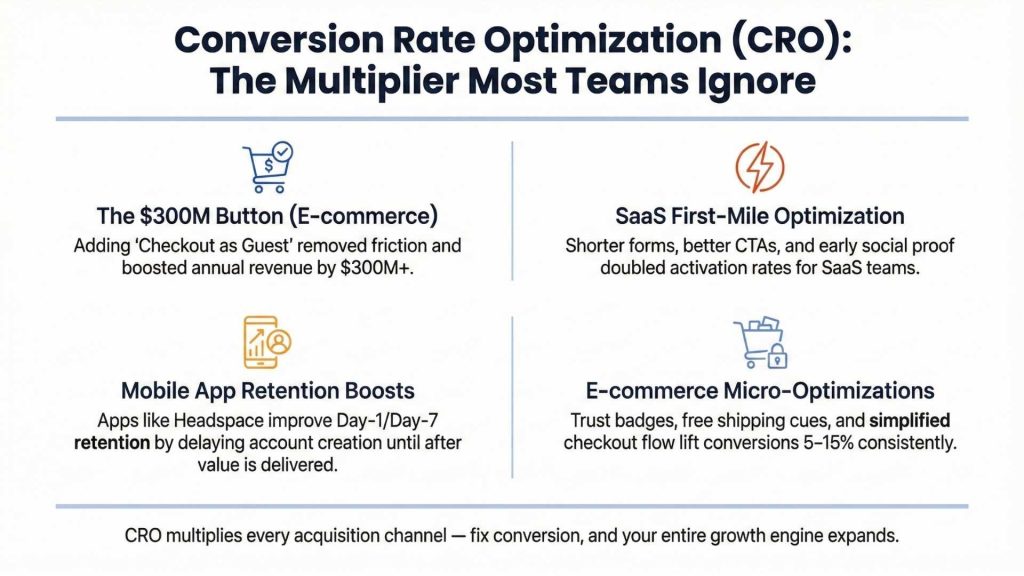
The $300 Million Button: A Classic Example
Let’s revisit a famous CRO case.
A major e-commerce retailer (name withheld, but verified via UIE) forced users to create an account before checking out. After usability testing, the team discovered a simple truth: new users hated this friction.
“I’m not here to start a relationship. I just want to buy something.”
They made one change:
Added a “Checkout as Guest” button.
- 45% increase in conversions.
- Over $300 million in additional revenue in the first year.
That’s the power of removing friction. A single UI tweak changed the economics of the business.
SaaS: Optimizing the First Few Minutes
In SaaS, CRO often focuses on what I call the “first mile”:
- How many people who land on your homepage start a free trial?
- How many of those who start a trial complete the onboarding?
- How many of them reach an “Aha” moment within 1–2 sessions?
Improving your homepage CTA copy, shortening your sign-up form, or removing one unnecessary step from onboarding can drive double-digit improvements in activation rate.
And when your entire funnel depends on free-to-paid conversion? That’s a huge lever.
I’ve seen a SaaS client double their activation rate by:
- Moving the pricing CTA above the fold
- Adding social proof right before the sign-up form
- Auto-selecting the most popular plan as the default
- Reducing their form from 6 fields to 2
None of this required a dev team. Just growth-minded experimentation.
Mobile Apps: Optimizing Onboarding = Retention
For mobile apps, especially in freemium models, onboarding is CRO.
Duolingo, Headspace, Calm, and other top apps obsess over:
- Where users drop off during the first session
- Which tooltips or intro flows increase Day 1 and Day 7 retention
- When to ask for push notification permission (never on the first screen!)
Headspace A/B tested their entire onboarding flow and found that delaying account creation until after users listened to their first meditation increased signups and retention significantly.
It’s all about leading with value, not forms.
CRO in E-commerce: Small Tweaks, Big Dollars
In e-commerce, CRO means constantly improving:
- Homepage layout and navigation
- Product page copy and image structure
- Checkout flow (speed, friction, trust signals)
- Payment options
- Exit-intent offers and cart abandonment flows
For example, adding:
- Trust badges or “free returns” copy near the checkout button
- Progress indicators during multi-step checkout
- Urgency triggers (“Only 3 left in stock!”)
…can often lift conversion by 5–15%, which compounds with every ad or SEO visit.
A growth team I worked with A/B tested free shipping vs. flat rate and saw 19% more completed checkouts when free shipping was highlighted upfront, even though their prices were the same.
How Growth Teams Approach CRO
Unlike traditional UX or design teams, growth teams treat CRO like a scientific process:
- Start with Funnel Mapping
Where are people dropping off? From ad click to checkout? From sign-up to activation? - Form a Hypothesis
“If we add testimonial social proof above the CTA, more users will trust the offer.” - Design Controlled Experiments
A/B test with proper sample size and consistent traffic sources. - Ship, Measure, Iterate
Use tools like VWO, Optimizely, or in-product frameworks. - Treat Wins Like Infrastructure
Don’t just “run a test.” Systematize wins into your base templates and onboarding systems.
What to Test First
If you’re not sure where to begin, start with:
- Headlines and subheadings (clarity and urgency)
- CTAs (text, position, color, button size)
- Form length and order (cut it down)
- Social proof (logos, testimonials, usage stats)
- Pricing page layout (emphasize the most recommended plan)
- Exit modals and retargeting messages
CRO is less about magic and more about relentless curiosity and iteration. You’ll be shocked at how often something you assumed was “working fine” is quietly killing conversions.
Final Thoughts: Growth Marketing as a Discipline
Let me end with this:
Growth marketing is not about hacks. It’s not just about running ads, making memes, or building referral programs.
It’s a discipline. A mindset. A cross-functional, data-driven way of building products and businesses.
It requires:
- Knowing your customer deeply
- Running constant, disciplined experiments
- Using data to guide, but not paralyze, your decisions
- Prioritizing scalable systems over one-off wins
- Partnering across product, engineering, design, sales, and support
And above all: learning fast, shipping faster, and letting compounding take care of the rest.
Every chapter in this article, SEO, content, paid, email, influencers, PLG, referrals, community, CRO, is a lever. Your job is to understand the system and know which lever to pull, when, and how hard.
That’s growth.
And in 2025 and beyond, companies that understand this will outlearn, outbuild, and outgrow the rest.

How We Think About Growth at RiseOpp
If this growth framework feels familiar, the fragmented channels, the underused data, the lack of a single owner for the whole funnel, you’re not alone. Many teams know what needs to happen in theory but struggle to turn it into a disciplined, cross-channel system in practice. That gap between strategy and execution is exactly where RiseOpp focuses.
As a Fractional CMO and GEO & SEO agency, RiseOpp works with B2B and B2C companies that need senior-level ownership of growth without adding a full-time C-suite headcount. Through its comprehensive Fractional CMO services, RiseOpp helps marketing leaders:
- Turn high-level growth aspirations into a concrete roadmap, budgets, and KPIs across SEO, paid media, lifecycle, and brand.
- Build or reshape the marketing team, from specialist hiring to agency orchestration, so each channel supports a single, coherent strategy.
- Implement the experimentation infrastructure that powers true growth marketing: testing, learning, and compounding wins instead of chasing disconnected tactics.
For organizations that see SEO as a core pillar of growth, RiseOpp also brings its proprietary Heavy SEO methodology, designed specifically to rank a site for tens of thousands of keywords over time. Heavy SEO goes beyond basic audits or a handful of “hero” keywords and instead builds durable, category-level visibility that compounds year after year.
Because AI is reshaping how decision-makers discover and evaluate brands, RiseOpp extends this foundation with AI Visibility Optimization (AIVO) and related GEO/AEO services, ensuring clients are not only visible in search engines but also in AI-generated answers, summaries, and overviews that increasingly influence buying decisions.
If the next step for your organization is not “one more campaign” but a cohesive, AI-era growth engine, this is the moment to formalize it. Explore RiseOpp’s Fractional CMO services to put a senior growth leader in charge of connecting strategy, team, and channels, and start turning this playbook into measurable, compounding results.
Comments are closed